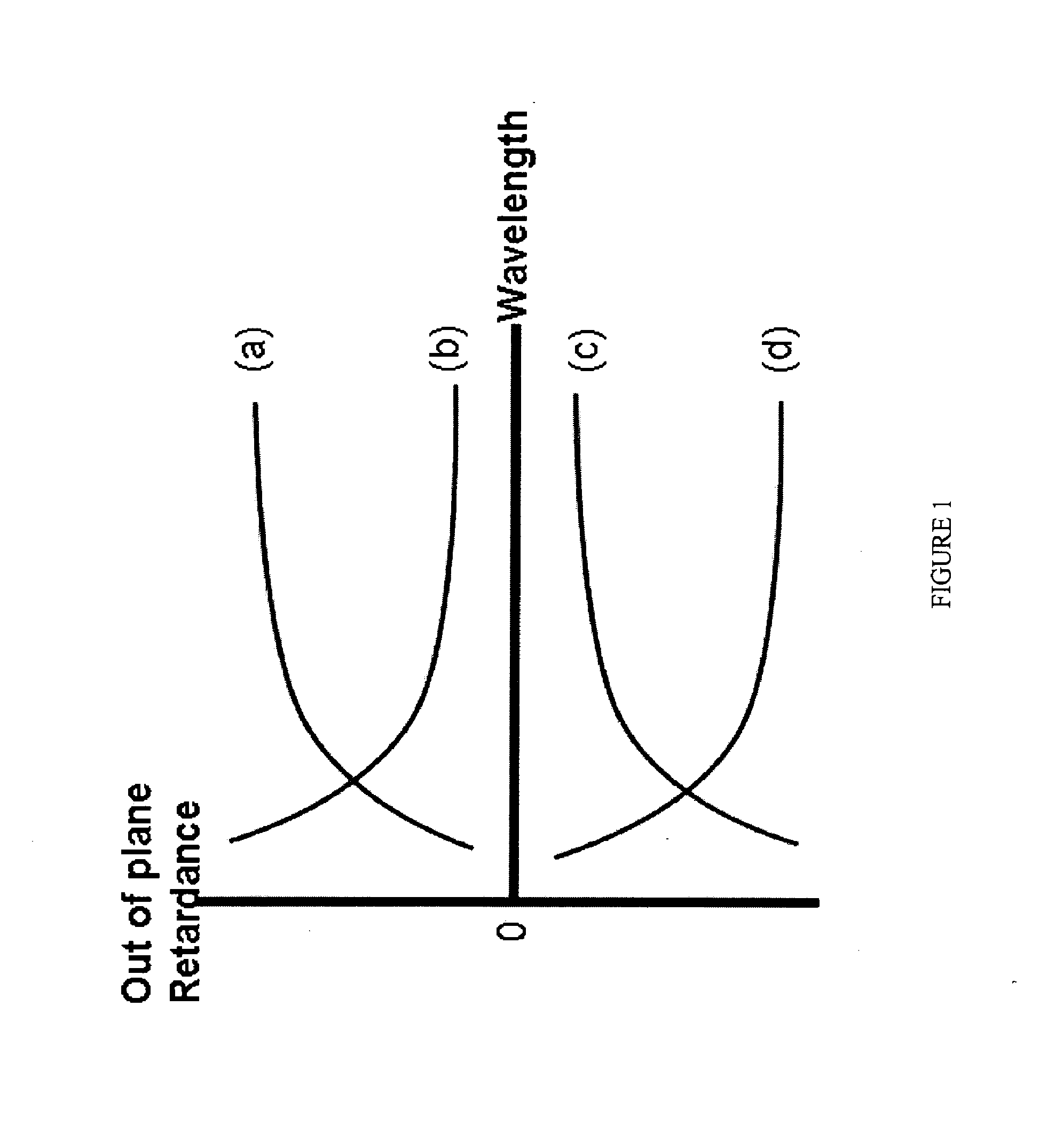Liquid crystal display having improved wavelength dispersion characteristics
a liquid crystal display and wavelength dispersion technology, applied in the field of optical compensation films, can solve the problems of color distortion due to wavelength dispersion of its proper retardation, poor image quality, and increase the dispersion in the lighted (on) sta
- Summary
- Abstract
- Description
- Claims
- Application Information
AI Technical Summary
Benefits of technology
Problems solved by technology
Method used
Image
Examples
example 1
Wavelength Dispersion Curves of Various Mesogen-Jacketed Polymer Films
[0140]Mesogen-Jacketed polymers identified as PC12, PC10, PC8, and PCt having the following repeating units, respectively, were prepared:
[0141]Optical compensation films (positive C-plates) were prepared by dissolving each polymer in toluene and solution casting onto a piece of Zeonorfilm® to form coatings, as shown in FIG. 5. The coatings were allowed to dry at room temperature to form thin films with thicknesses of about 3 μm. Zeonorfilm® is a 100 μm thick substrate made of Cyclo Olifen Polymers (COP) manufactured by Zeon Chemicals, L.P. Zeonorfilm® was chosen as the substrate because it has negligible retardation throughout the wavelength range 400 nm-800 nm. The phase retardance of light passing through each film / substrate sample was measured by VASE® Ellipsometer (available from J. A. Woollam Co., Inc.). The ellipsometer was calibrated by silica every time before using. FIG. 6 shows the wavelength dispersion ...
example 2
UV Spectra of Various Mesogen-Jacketed Polymers
[0143]The following table is a collection of the absorption maximum (λmax) and the birefringence (Δn) measured at the wavelength of 633 nm for each polymer, as shown in FIG. 7.
TABLE 2Sampleλmax, nmΔn (633)PC6319.80.0355PC8319.10.0362PC10315.70.0295PC12319.80.0229PCt309.60.0184
As illustrated in Tables 1 and 2, polymers having steep slopes at shorter wavelengths generally have UV absorption maxima between 280 nm and 350 nm. Films prepared from such polymers exhibit exceptionally high positive birefringence, as shown in Table 2.
example 3
Wavelength Dispersion Curves Obtained by Stacking Polyimide Film with Mesogen-Jacketed Polymer Film
[0144]A multilayer film comprising a mesogen-jacketed polymer (PC6) film (positive C-plate) and a polyimide film APSC2 (negative C-plate) was prepared. The polyimide was dissolved in methyl isobutyl ketone (MIBK) and solution cast onto a TAC film having a thickness of 80 μm. The polyimide thickness was about 4 μm. The film was subsequently coated with a solution of mesogen-jacketed polymer, PC6, in toluene to form multilayer films with different thicknesses of the PC6 film. PC6-1 is approximately 1 μm thick; PC6-2 is approximately 2.5 μm thick; PC6-3 is approximately 3 μm thick; and PC6-4 is approximately 5 μm thick. FIG. 8 illustrates the multilayer film with PC6 as the positive C-plate. FIG. 9 shows that the out-of-plane retardation of the samples with increasing thickness of the PC6 film. The samples with the thickest positive C-plates (PC6) had an overall positive retardation. Thin...
PUM
| Property | Measurement | Unit |
|---|---|---|
| wavelengths | aaaaa | aaaaa |
| thickness | aaaaa | aaaaa |
| wavelength range | aaaaa | aaaaa |
Abstract
Description
Claims
Application Information
 Login to View More
Login to View More - R&D
- Intellectual Property
- Life Sciences
- Materials
- Tech Scout
- Unparalleled Data Quality
- Higher Quality Content
- 60% Fewer Hallucinations
Browse by: Latest US Patents, China's latest patents, Technical Efficacy Thesaurus, Application Domain, Technology Topic, Popular Technical Reports.
© 2025 PatSnap. All rights reserved.Legal|Privacy policy|Modern Slavery Act Transparency Statement|Sitemap|About US| Contact US: help@patsnap.com



